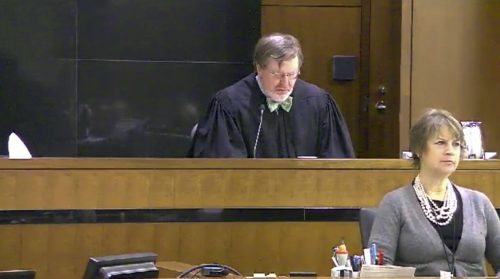President Donald Trump’s executive order on immigration was blocked by an appeals court Feb. 9 after the federal appeals panel found no evidence that anyone from the seven nations had committed acts of terrorism.
There are 94 district courts, 13 circuit courts, and one Supreme Court in the federal system, which interprets laws. However, the ability to overturn executive orders can come from more than just a federal court ruling.
“The president can revoke or rescind it,” David Barnum, emeritus professor of political science, said. “And I think that is what President Trump has done in many cases.”
Article two of the constitution prescribes in detail the executive branch’s power, however, through what is known as an executive order, the president has the right to sign a law that does not need prior approval from anyone. It is only in bringing an executive order before the federal courts that any president’s reach can be cut down.
On Jan. 27, 2017 President Donald Trump signed “Protection Of The Nation From Foreign Terrorist Entry Into The United States,” which banned seven Muslim-majority countries from entering the U.S., regardless of legal resident status. It sent immigrants back on planes, and detained multitudes of individuals at local airports across the country. This “travel ban” is where the questions begin, and it is where the courts will once again be called to limit the power of the president if need be.

In court documents released from the United States Eastern Court District of New York, Judge Ann Donnelly revoked parts of the president’s executive action days into the implementation of the executive order.
Darweesh v. Trump Order was the first challenge. The judicial branch took exceptions to the parts of the order which had legal residents turned away in airports, even after making it back to America.
“I think that Trump’s very aggressive use of executive orders is going to generate tons of litigation in the courts,” Barnum said. “Much of which is going to turn up the fact that if the order makes it to the Supreme Court there isn’t much precedent to consider.”
This is what may happen with another court ruling, one in which the executive order has been challenged yet again. In the Western District court of Washington at Seattle, documents were released Feb. 3, which noted the state of Washington and Minnesota had filed another court case against the Trump order.
District Judge James L. Robart issued a temporary restraining order. This temporary order nullified the entire executive action. Barnum said that the executive branch has been trying to get around congress for years, and possibly decades, but notes that the case will only reach the Supreme Court on appeal.
Oral arguments were heard against the temporary restraining order on Feb. 7, with the Ninth Circuit Court of Appeals. The court decided to uphold the halt of the travel ban, and the White House said that it may take the fight over the halt to the Supreme Court.
“Theoretically, the formal position of our constitution is nothing belongs to the executive branch, except maybe the president’s power to be commander-in-chief once we’re in a war, and a few other things,” Barnum said. “But congress passes laws and the president enforces laws, he doesn’t make them.”
Barnum also said that these litigations against the Trump executive order are going to be tested repeatedly.
To make the current situation more muddled, the Supreme Court still only has eight sitting judges. The president has picked Neil Gorsuch, but he is still awaiting congress approval. If this current case gets all the way to the Supreme Court and ends in a tie, the lesser court’s ruling would be upheld.
Kinga Rzezinowska, a DePaul freshman, is worried about the rights of refugees and immigrants if the order is unhalted.
“I’m an immigrant and my parents are too,” Rzezinowska said. “There should definitely be checks and balances, just to protect everybody’s rights.”
Although Rzezinowska does not hail from one of the countries on the travel ban order, as immigrants, she says she and her parents feel affected by Trump’s order.
This chain events may be unprecedented in some way, but it isn’t the first time an executive order has been challenged. According to a Congressional Research Service report, Youngstown Sheet and Tube Co. v. Sawyer was a Supreme Court ruling that reversed President Harry S. Truman’s executive order to seize control of the nation’s steel mills during the Korean War in 1952.
In United States v. Texas, public court documents reveal that President Barack Obama had his executive action on immigration revoked. The order was part of a program initiated by Obama called, The Deferred Action for Parents of Americans and Lawful Permanent Residents, or DAPA.
Aside from executive orders, there are other ways unconstitutional laws can be rescinded. A landmark ruling on June 2015 set Jim Obergefell on the Supreme Court stage, when the state of Ohio did not recognize his marriage to his late spouse John Arthur.
In Obergefell v. Hodges, Obergefell, along with several other plaintiffs from Michigan, Kentucky and Tennessee, appealed to the Supreme Court and won.
“I guess that would be something that affects me here,” Emily Kuperman, a DePaul sophomore, said. “I know people that were probably going to be interested in having same sex marriages, and I think it’s important that they get to do what they want to do.”

